Exhibit 99.1
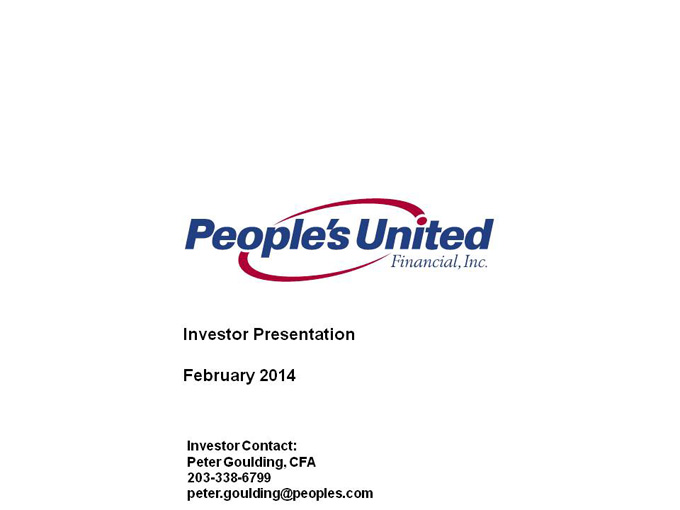
Exhibit 99.1
Investor Presentation
February 2014
Investor Contact: Peter Goulding, CFA 203-338-6799 peter.goulding@peoples.com
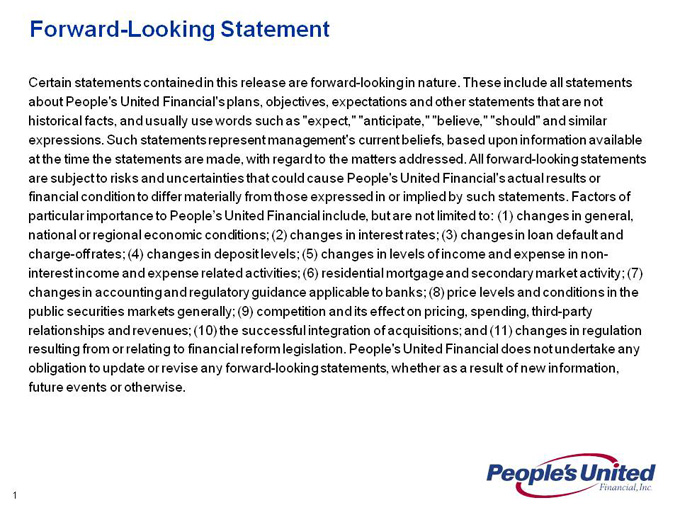
Forward-Looking Statement
Certain statements contained in this release are forward-looking in nature. These include all statements about People’s United Financial’s plans, objectives, expectations and other statements that are not historical facts, and usually use words such as “expect,” “anticipate,” “believe,” “should” and similar expressions. Such statements represent management’s current beliefs, based upon information available at the time the statements are made, with regard to the matters addressed. All forward-looking statements are subject to risks and uncertainties that could cause People’s United Financial’s actual results or financial condition to differ materially from those expressed in or implied by such statements. Factors of particular importance to People’s United Financial include, but are not limited to: (1) changes in general, national or regional economic conditions; (2) changes in interest rates; (3) changes in loan default and charge-off rates; (4) changes in deposit levels; (5) changes in levels of income and expense in non-interest income and expense related activities; (6) residential mortgage and secondary market activity; (7) changes in accounting and regulatory guidance applicable to banks; (8) price levels and conditions in the public securities markets generally; (9) competition and its effect on pricing, spending, third-party relationships and revenues; (10) the successful integration of acquisitions; and (11) changes in regulation resulting from or relating to financial reform legislation. People’s United Financial does not undertake any obligation to update or revise any forward-looking statements, whether as a result of new information, future events or otherwise.
1
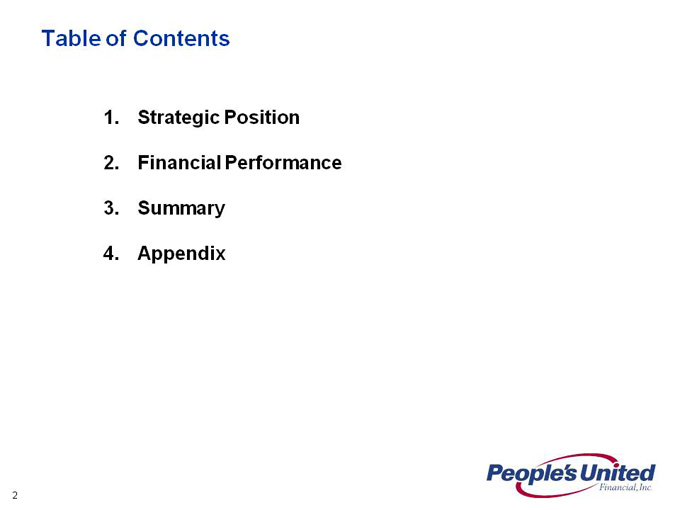
Table of Contents
1. Strategic Position
2. Financial Performance
3. Summary
4. Appendix
2
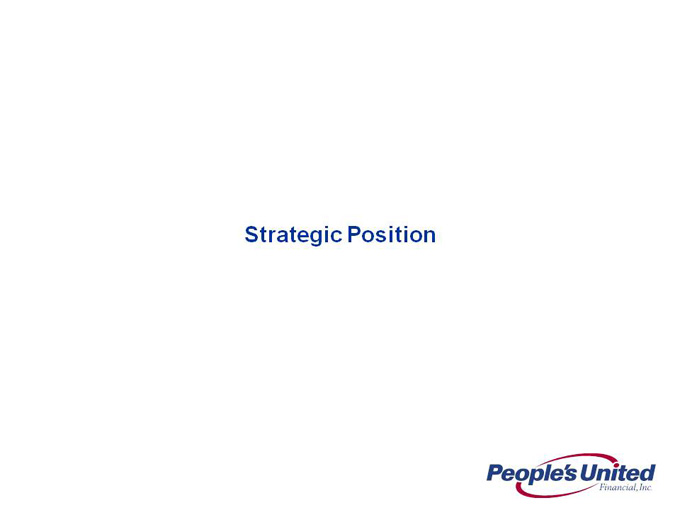
Strategic Position
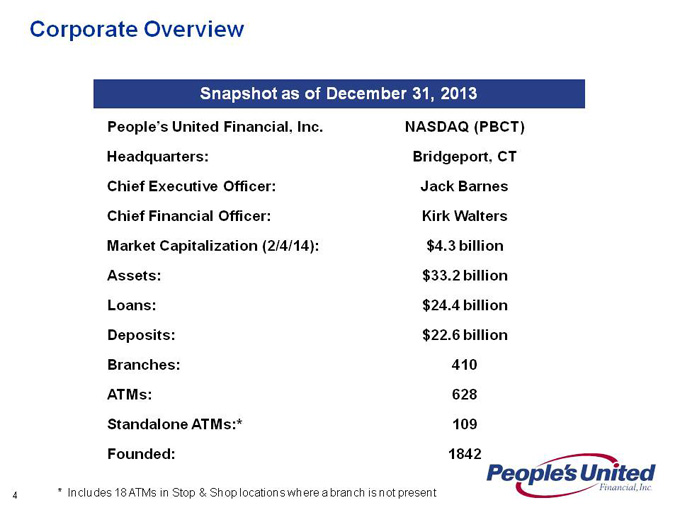
Corporate Overview
Snapshot as of December 31, 2013
People’s United Financial, Inc. NASDAQ (PBCT)
Headquarters: Bridgeport, CT
Chief Executive Officer: Jack Barnes
Chief Financial Officer: Kirk Walters
Market Capitalization (2/4/14): $4.3 billion
Assets: $33.2 billion
Loans: $24.4 billion
Deposits: $22.6 billion
Branches: 410
ATMs: 628
Standalone ATMs:* 109
Founded: 1842
* |
| Includes 18 ATMs in Stop & Shop locations where a branch is not present |
4 |
|
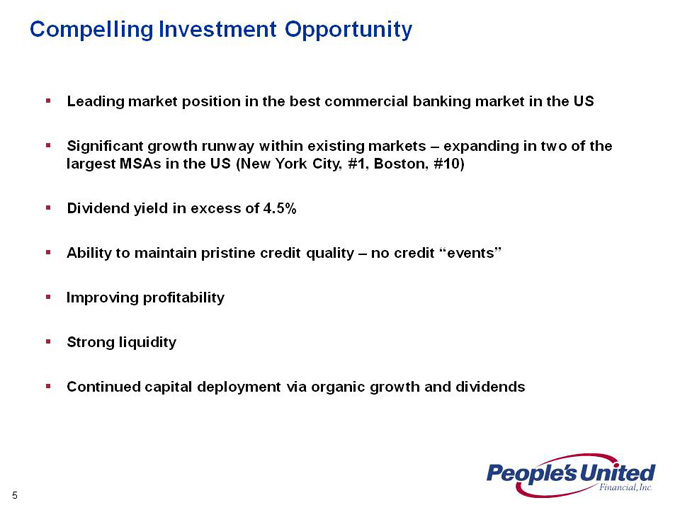
Compelling Investment Opportunity
Leading market position in the best commercial banking market in the US
Significant growth runway within existing markets – expanding in two of the largest MSAs in the US (New York City, #1, Boston, #10)
Dividend yield in excess of 4.5%
Ability to maintain pristine credit quality – no credit “events” Improving profitability Strong liquidity Continued capital deployment via organic growth and dividends
5
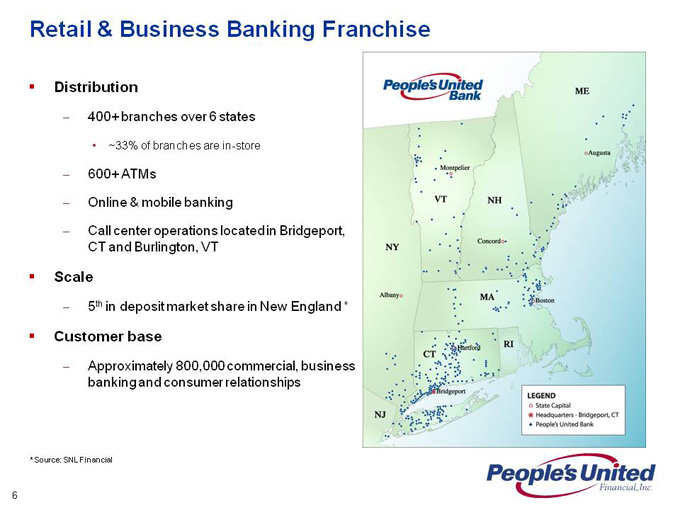
Retail & Business Banking Franchise
Distribution
400+ branches over 6 states
~33% of branches are in-store
600+ ATMs
Online & mobile banking
Call center operations located in Bridgeport, CT and Burlington, VT
Scale
5th in deposit market share in New England *
Customer base
Approximately 800,000 commercial, business banking and consumer relationships
* Source: SNL Financial
6
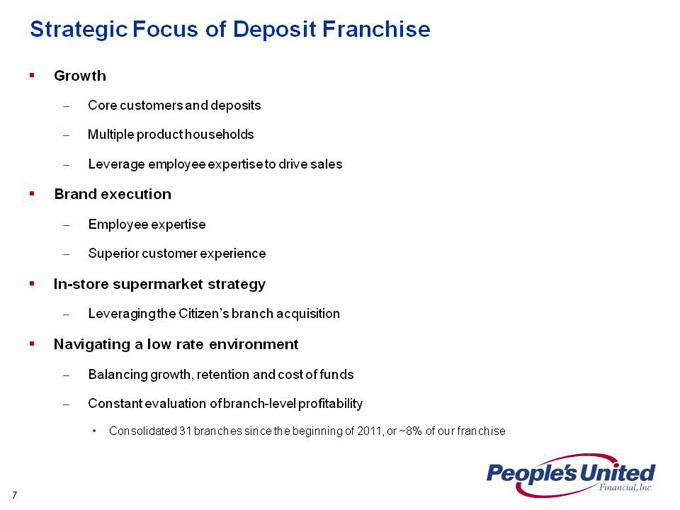
Strategic Focus of Deposit Franchise
Growth
Core customers and deposits
Multiple product households
Leverage employee expertise to drive sales
Brand execution
Employee expertise
Superior customer experience
In-store supermarket strategy
Leveraging the Citizen’s branch acquisition
Navigating a low rate environment
Balancing growth, retention and cost of funds
Constant evaluation of branch-level profitability
Consolidated 31 branches since the beginning of 2011, or ~8% of our franchise
7
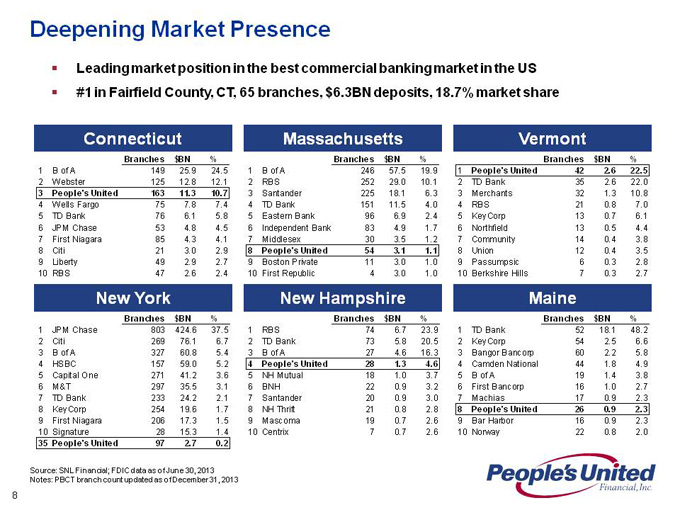
Deepening Market Presence
Leading market position in the best commercial banking market in the US #1 in Fairfield County, CT, 65 branches, $6.3BN deposits, 18.7% market share
Connecticut Massachusetts Vermont
Branches $BN% Branches $BN% Branches $BN%
1 B of A 149 25.9 24.5 1 B of A 246 57.5 19.9 1 People’s United 42 2.6 22.5
2 Webster 125 12.8 12.1 2 RBS 252 29.0 10.1 2 TD Bank 35 2.6 22.0
3 People’s United 163 11.3 10.7 3 Santander 225 18.1 6.3 3 Merchants 32 1.3 10.8
4 Wells Fargo 75 7.8 7.4 4 TD Bank 151 11.5 4.0 4 RBS 21 0.8 7.0
5 TD Bank 76 6.1 5.8 5 Eastern Bank 96 6.9 2.4 5 KeyCorp 13 0.7 6.1
6 JPM Chase 53 4.8 4.5 6 Independent Bank 83 4.9 1.7 6 Northfield 13 0.5 4.4
7 First Niagara 85 4.3 4.1 7 Middlesex 30 3.5 1.2 7 Community 14 0.4 3.8
8 Citi 21 3.0 2.9 8 People’s United 54 3.1 1.1 8 Union 12 0.4 3.5
9 Liberty 49 2.9 2.7 9 Boston Private 11 3.0 1.0 9 Passumpsic 6 0.3 2.8
10 RBS 47 2.6 2.4 10 First Republic 4 3.0 1.0 10 Berkshire Hills 7 0.3 2.7
New York New Hampshire Maine
Branches $BN% Branches $BN% Branches $BN%
1 JPM Chase 803 424.6 37.5 1 RBS 74 6.7 23.9 1 TD Bank 52 18.1 48.2
2 Citi 269 76.1 6.7 2 TD Bank 73 5.8 20.5 2 KeyCorp 54 2.5 6.6
3 B of A 327 60.8 5.4 3 B of A 27 4.6 16.3 3 Bangor Bancorp 60 2.2 5.8
4 HSBC 157 59.0 5.2 4 People’s United 28 1.3 4.6 4 Camden National 44 1.8 4.9
5 Capital One 271 41.2 3.6 5 NH Mutual 18 1.0 3.7 5 B of A 19 1.4 3.8
6 M&T 297 35.5 3.1 6 BNH 22 0.9 3.2 6 First Bancorp 16 1.0 2.7
7 TD Bank 233 24.2 2.1 7 Santander 20 0.9 3.0 7 Machias 17 0.9 2.3
8 KeyCorp 254 19.6 1.7 8 NH Thrift 21 0.8 2.8 8 People’s United 26 0.9 2.3
9 First Niagara 206 17.3 1.5 9 Mascoma 19 0.7 2.6 9 Bar Harbor 16 0.9 2.3
10 Signature 28 15.3 1.4 10 Centrix 7 0.7 2.6 10 Norway 22 0.8 2.0
35 People’s United 97 2.7 0.2
Source: SNL Financial; FDIC data as of June 30, 2013
Notes: PBCT branch count updated as of December 31, 2013
8
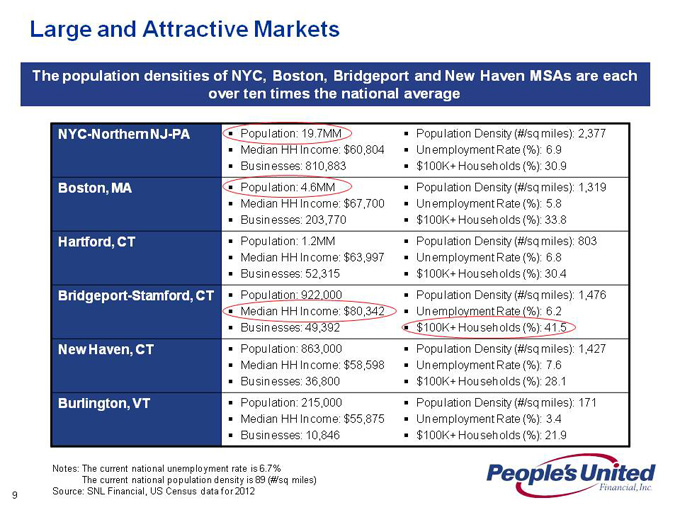
Large and Attractive Markets
The population densities of NYC, Boston, Bridgeport and New Haven MSAs are each over ten times the national average
NYC-Northern NJ-PA ? Population: 19.7MM ??Population Density (#/sq miles): 2,377
? Median HH Income: $ 60,804 ??Unemployment Rate (%): 6.9
? Businesses: 810,883 ??$100K+ Households (%): 30.9
Boston, MA ? Population: 4.6MM ??Population Density (#/sq miles): 1,319
? Median HH Income: $ 67,700 ??Unemployment Rate (%): 5.8
? Businesses: 203,770 ??$100K+ Households (%): 33.8
Hartford, CT ? Population: 1.2MM ??Population Density (#/sq miles): 803
? Median HH Income: $ 63,997 ??Unemployment Rate (%): 6.8
? Businesses: 52,315 ??$100K+ Households (%): 30.4
Bridgeport-Stamford, CT ? Population: 922,000 ??Population Density (#/sq miles): 1,476
? Median HH Income: $ 80,342 ??Unemployment Rate (%): 6.2
? Businesses: 49,392 ??$100K+ Households (%): 41.5
New Haven, CT ? Population: 863,000 ??Population Density (#/sq miles): 1,427
? Median HH Income: $ 58,598 ??Unemployment Rate (%): 7.6
? Businesses: 36,800 ??$100K+ Households (%): 28.1
Burlington, VT ? Population: 215,000 ??Population Density (#/sq miles): 171
? Median HH Income: $ 55,875 ??Unemployment Rate (%): 3.4
? Businesses: 10,846 ??$100K+ Households (%): 21.9
Notes: The current national unemployment rate is 6.7%
The current national population density is 89 (#/sq miles) Source: SNL Financial, US Census data for 2012
9
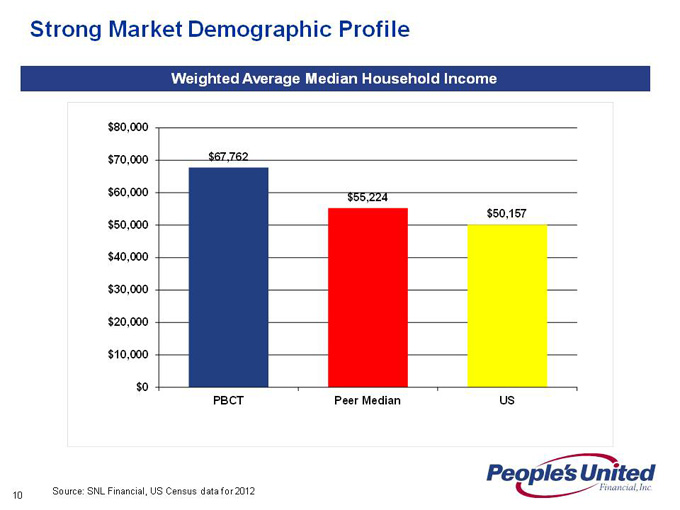
Strong Market Demographic Profile
Weighted Average Median Household Income
$80,000
$70,000 $67,762
$60,000 $55,224 $50,157 $50,000
$40,000 $30,000 $20,000 $10,000
$0
PBCT Peer Median US
Source: SNL Financial, US Census data for 2012
10
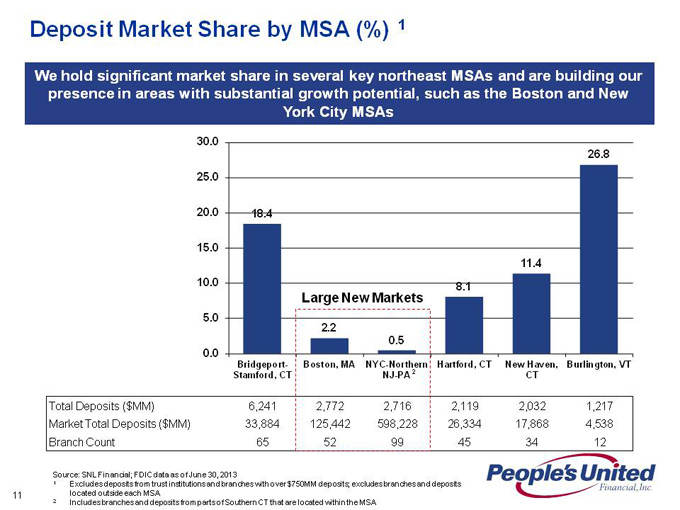
Deposit Market Share by MSA (%) 1
We hold significant market share in several key northeast MSAs and are building our presence in areas with substantial growth potential, such as the Boston and New York City MSAs
30.0
26.8
25.0
20.0 18.4
15.0
11.4
10.0 8.1
Large New Markets
5.0 2.2
0.5
0.0
Bridgeport- Boston, MA NYC-Northern Hartford, CT New Haven, Burlington, VT Stamford, CT NJ-PA 2 CT
Total Deposits ($MM) 6,241 2,772 2,716 2,119 2,032 1,217 Market Total Deposits ($MM) 33,884 125,442 598,228 26,334 17,868 4,538 Branch Count 65 52 99 45 34 12
Source: SNL Financial; FDIC data as of June 30, 2013
1 Excludes deposits from trust institutions and branches with over $750MM deposits; excludes branches and deposits located outside each MSA
2 Includes branches and deposits from parts of Southern CT that are located within the MSA
11
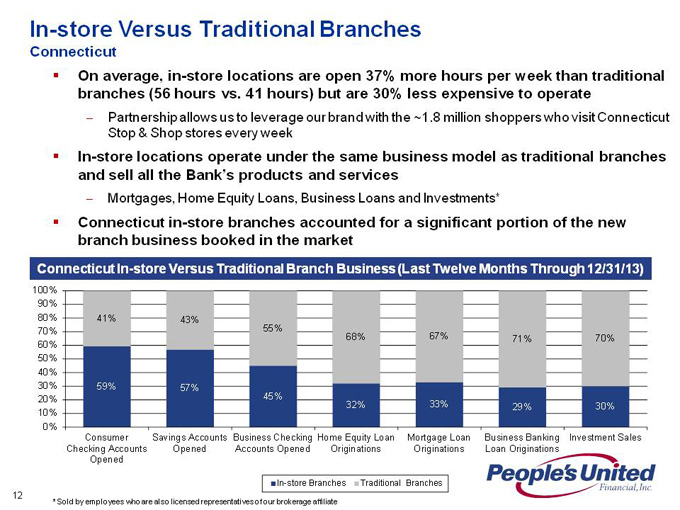
In-store Versus Traditional Branches
Connecticut
On average, in-store locations are open 37% more hours per week than traditional branches (56 hours vs. 41 hours) but are 30% less expensive to operate
Partnership allows us to leverage our brand with the ~1.8 million shoppers who visit Connecticut Stop & Shop stores every week
In-store locations operate under the same business model as traditional branches and sell all the Bank’s products and services
Mortgages, Home Equity Loans, Business Loans and Investments*
Connecticut in-store branches accounted for a significant portion of the new branch business booked in the market
Connecticut In-store Versus Traditional Branch Business (Last Twelve Months Through 12/31/13)
100%
90%
80% 41% 43%
70% 55% 67%
60% 68% 71% 70% 50% 40% 30% 59% 57% 20% 45% 33% 10% 32% 29% 30% 0% Consumer Savings Accounts Business Checking Home Equity Loan Mortgage Loan Business Banking Investment Sales Checking Accounts Opened Accounts Opened Originations Originations Loan Originations Opened
In-store Branches Traditional Branches
* Sold by employees who are also licensed representatives of our brokerage affiliate
12
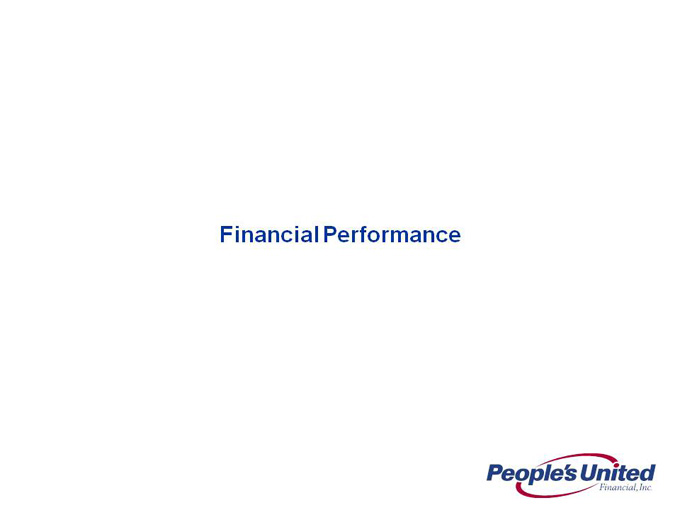
Financial Performance
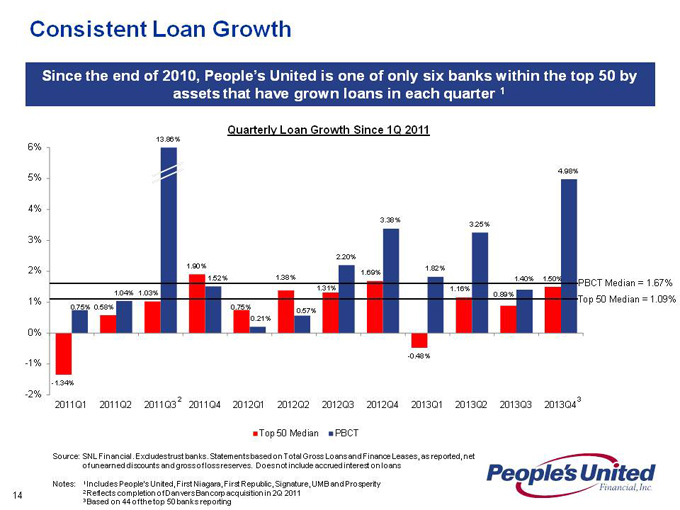
Consistent Loan Growth
Since the end of 2010, People’s United is one of only six banks within the top 50 by assets that have grown loans in each quarter 1
Quarterly Loan Growth Since 1Q 2011
13.86%
6%
5% 4.98%
4%
3.38%
3.25%
3%
2.20%
1.90% 1.82%
2% 1.52% 1.38% 1.69%
1.40% 1.50% PBCT Median = 1.67%
1.31% 1.16%
1.04% 1.03% 0.89%
1% Top 50 Median = 1.09%
0.75% 0.58% 0.75%
0.57%
0.21%
0%
-1% -0.48% -1.34%
-2%
2 3
2011Q1 2011Q2 2011Q3 2011Q4 2012Q1 2012Q2 2012Q3 2012Q4 2013Q1 2013Q2 2013Q3 2013Q4
Top 50 Median PBCT
Source: SNL Financial. Excludes trust banks. Statements based on Total Gross Loans and Finance Leases, as reported, net of unearned discounts and gross of loss reserves. Does not include accrued interest on loans
Notes: 1 Includes People’s United, First Niagara, First Republic, Signature, UMB and Prosperity
14 2 Reflects completion of Danvers Bancorp acquisition in 2Q 2011
3 Based on 44 of the top 50 banks reporting
14
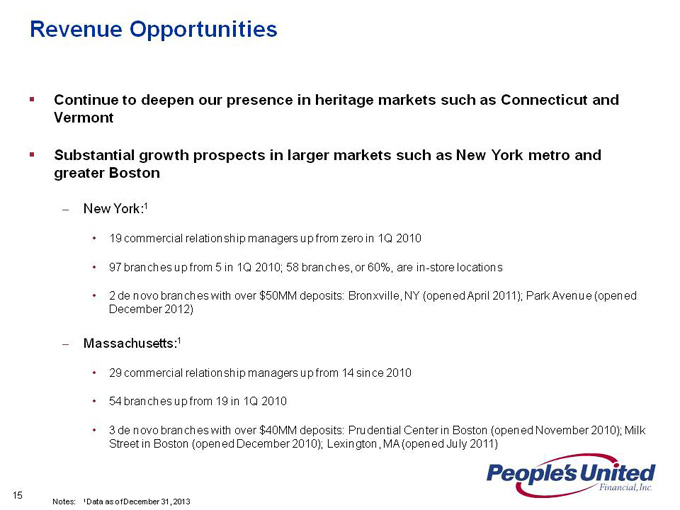
Revenue Opportunities
Continue to deepen our presence in heritage markets such as Connecticut and Vermont
Substantial growth prospects in larger markets such as New York metro and greater Boston
New York:1
19 commercial relationship managers up from zero in 1Q 2010
97 branches up from 5 in 1Q 2010; 58 branches, or 60%, are in-store locations
2 de novo branches with over $50MM deposits: Bronxville, NY (opened April 2011); Park Avenue (opened December 2012)
Massachusetts:1
29 commercial relationship managers up from 14 since 2010
54 branches up from 19 in 1Q 2010
3 de novo branches with over $40MM deposits: Prudential Center in Boston (opened November 2010); Milk Street in Boston (opened December 2010); Lexington, MA (opened July 2011)
Notes: 1 Data as of December 31, 2013
15
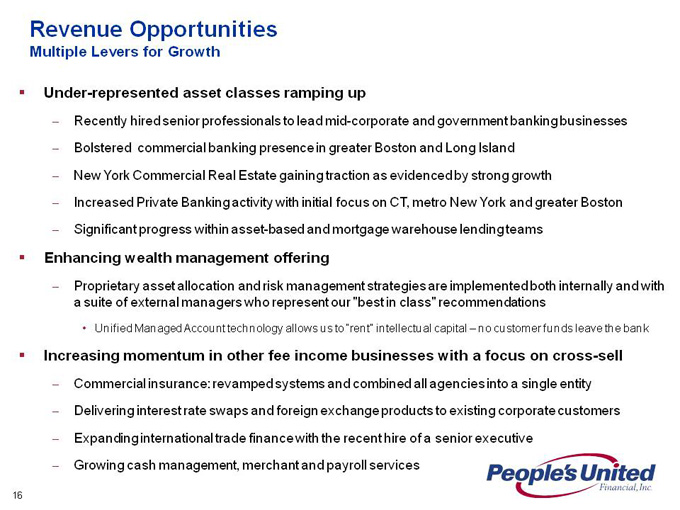
Revenue Opportunities
Multiple Levers for Growth
Under-represented asset classes ramping up
Recently hired senior professionals to lead mid-corporate and government banking businesses Bolstered commercial banking presence in greater Boston and Long Island New York Commercial Real Estate gaining traction as evidenced by strong growth Increased Private Banking activity with initial focus on CT, metro New York and greater Boston Significant progress within asset-based and mortgage warehouse lending teams
Enhancing wealth management offering
Proprietary asset allocation and risk management strategies are implemented both internally and with a suite of external managers who represent our “best in class” recommendations
Unified Managed Account technology allows us to “rent” intellectual capital – no customer funds leave the bank
Increasing momentum in other fee income businesses with a focus on cross-sell
Commercial insurance: revamped systems and combined all agencies into a single entity Delivering interest rate swaps and foreign exchange products to existing corporate customers Expanding international trade finance with the recent hire of a senior executive Growing cash management, merchant and payroll services
16
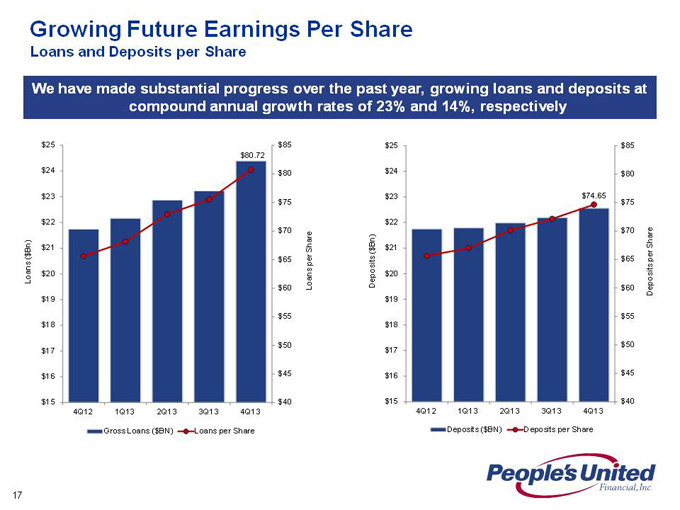
Growing Future Earnings Per Share
Loans and Deposits per Share
We have made substantial progress over the past year, growing loans and deposits at compound annual growth rates of 23% and 14%, respectively
$25 $85 $25 $85
$80.72
$24 $80 $24 $80
$23 $23 $74.65
$75 $75
$22 $22
$70 $70
Bn) Share Bn) $21 Share $ $21 ( $ ( per
$65 $65 per Loans $20 Loans Deposits $20
$60 $60 Deposits
$19 $19
$55 $55
$18 $18
$50 $50
$17 $17
$16 $45 $16 $45
$15 $40 $15 $40 4Q12 1Q13 2Q13 3Q13 4Q13 4Q12 1Q13 2Q13 3Q13 4Q13
Gross Loans ($BN) Loans per Share Deposits ($BN) Deposits per Share
17
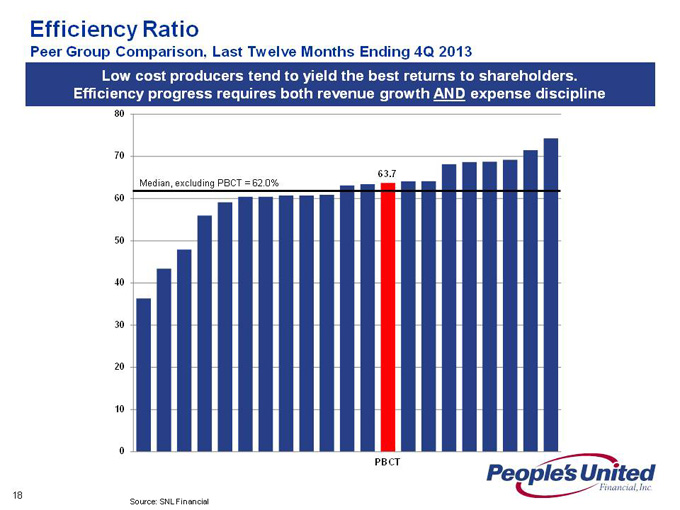
Efficiency Ratio
Peer Group Comparison, Last Twelve Months Ending 4Q 2013
Low cost producers tend to yield the best returns to shareholders. Efficiency progress requires both revenue growth AND expense discipline
80
70
63.7
Median, excluding PBCT = 62.0%
60 50 40 30 20 10
0
PBCT
Source: SNL Financial
18
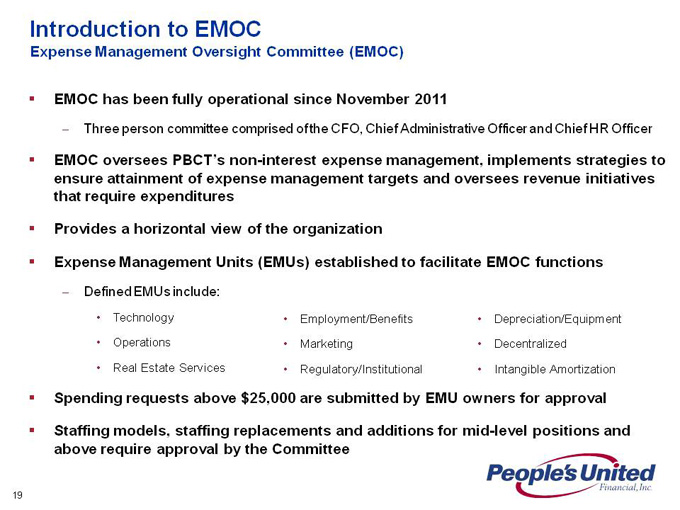
Introduction to EMOC
Expense Management Oversight Committee (EMOC)
EMOC has been fully operational since November 2011
Three person committee comprised of the CFO, Chief Administrative Officer and Chief HR Officer
EMOC oversees PBCT’s non-interest expense management, implements strategies ensure attainment of expense management targets and oversees revenue initiatives that require expenditures
Provides a horizontal view of the organization
Expense Management Units (EMUs) established to facilitate EMOC functions
Defined EMUs include:
Technology Employment/Benefits Depreciation/Equipment
Operations Marketing Decentralized
Real Estate Services Regulatory/Institutional Intangible Amortization
Spending requests above $25,000 are submitted by EMU owners for approval
Staffing models, staffing replacements and additions for mid-level positions and above require approval by the Committee
19
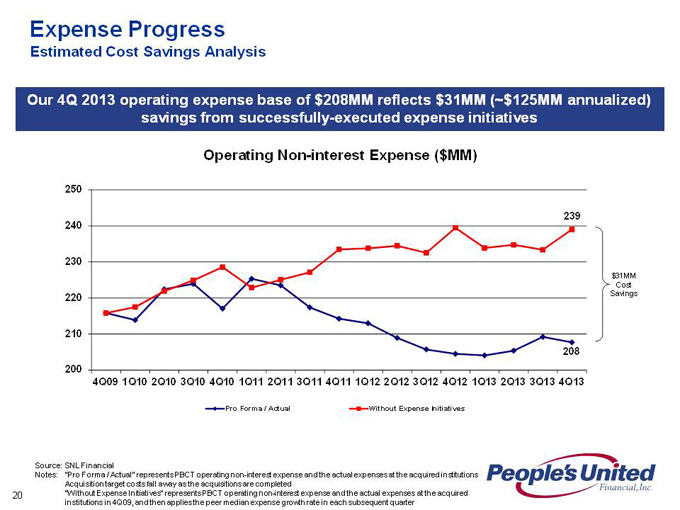
Expense Progress
Estimated Cost Savings Analysis
Our 4Q 2013 operating expense base of $208MM reflects $31MM (~$125MM annualized) savings from successfully-executed expense initiatives
Operating Non-interest Expense ($MM)
250
240 239
230
$31MM Cost 220 Savings
210
208 200 4Q09 1Q10 2Q10 3Q10 4Q10 1Q11 2Q11 3Q11 4Q11 1Q12 2Q12 3Q12 4Q12 1Q13 2Q13 3Q13 4Q13
Pro Forma / Actual Without Expense Initiatives
Source: SNL Financial
Notes: “Pro Forma / Actual” represents PBCT operating non-interest expense and the actual expenses at the acquired institutions Acquisition target costs fall away as the acquisitions are completed
“Without Expense Initiatives” represents PBCT operating non-interest expense and the actual expenses at the acquired institutions in 4Q09, and then applies the peer median expense growth rate in each subsequent quarter
20
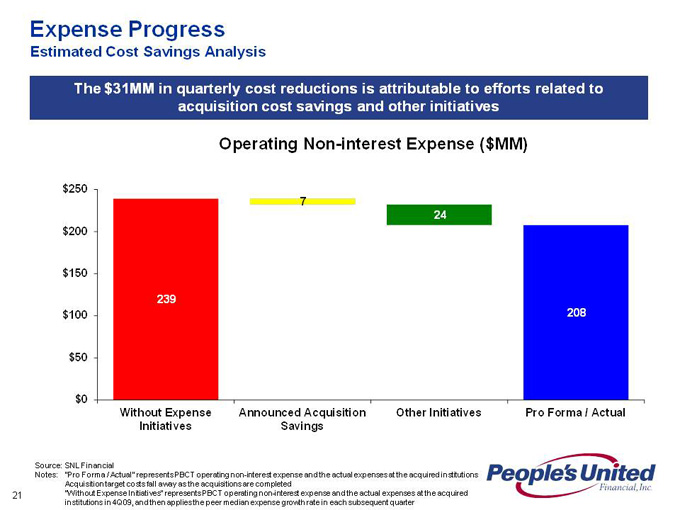
Expense Progress
Estimated Cost Savings Analysis
The $31MM in quarterly cost reductions is attributable to efforts related to acquisition cost savings and other initiatives
Operating Non-interest Expense ($MM)
$250
7
24 $200
$150
239 $100 208
$50
$0
Without Expense Announced Acquisition Other Initiatives Pro Forma / Actual Initiatives Savings
Source: SNL Financial
Notes: “Pro Forma / Actual” represents PBCT operating non-interest expense and the actual expenses at the acquired institutions Acquisition target costs fall away as the acquisitions are completed
“Without Expense Initiatives” represents PBCT operating non-interest expense and the actual expenses at the acquired institutions in 4Q09, and then applies the peer median expense growth rate in each subsequent quarter
21
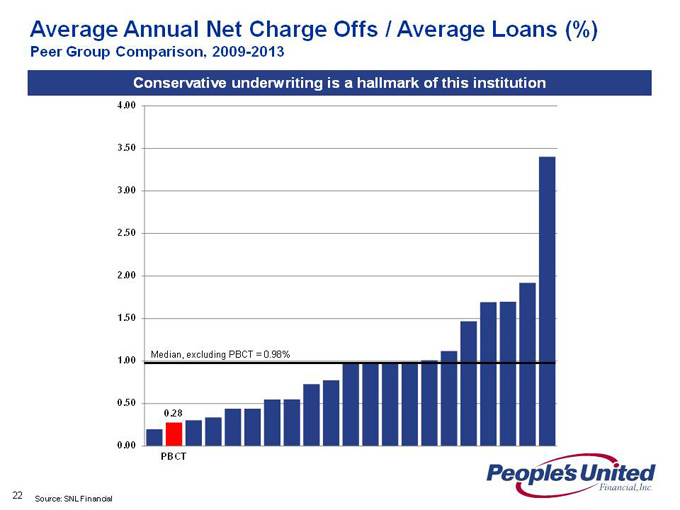
Average Annual Net Charge Offs / Average Loans (%)
Peer Group Comparison, 2009-2013
Conservative underwriting is a hallmark of this institution
4.00
3.50
3.00
2.50
2.00
1.50
Median, excluding PBCT = 0.98%
1.00
0.50
0.28
0.00
PBCT
Source: SNL Financial
22
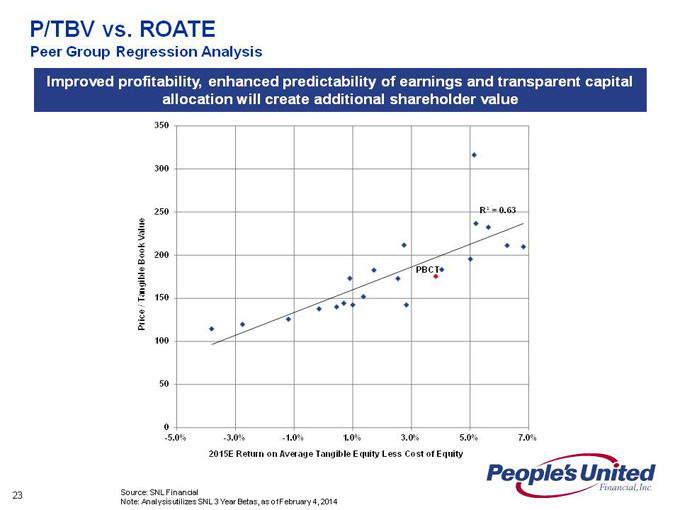
P/TBV vs. ROATE
Peer Group Regression Analysis
Improved profitability, enhanced predictability of earnings and transparent capital allocation will create additional shareholder value
350
300
250 R² = 0.63 alue V
Book 200
PBCT
Tangible 150 / Price 100
50
0
-5.0% -3.0% -1.0% 1.0% 3.0% 5.0% 7.0% 2015E Return on Average Tangible Equity Less Cost of Equity
Source: SNL Financial
Note: Analysis utilizes SNL 3 Year Betas, as of February 4, 2014
23
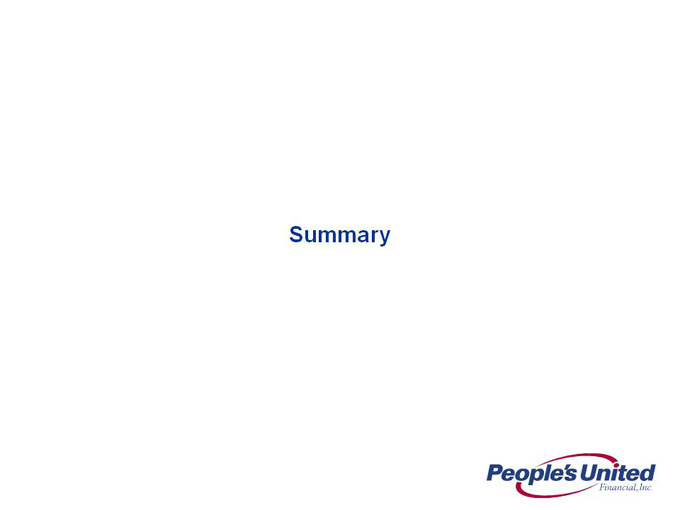
Summary
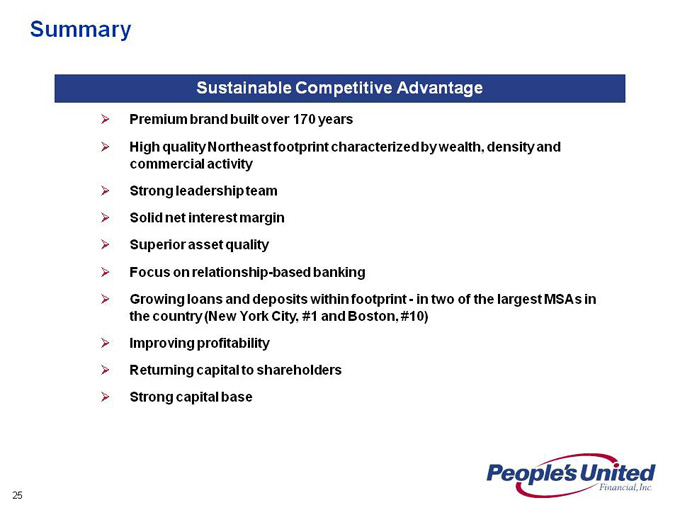
Summary
Sustainable Competitive Advantage
Premium brand built over 170 years
High quality Northeast footprint characterized by wealth, density and commercial activity
Strong leadership team Solid net interest margin Superior asset quality
Focus on relationship-based banking
Growing loans and deposits within footprint—in two of the largest MSAs in the country (New York City, #1 and Boston, #10)
Improving profitability
Returning capital to shareholders
Strong capital base
25
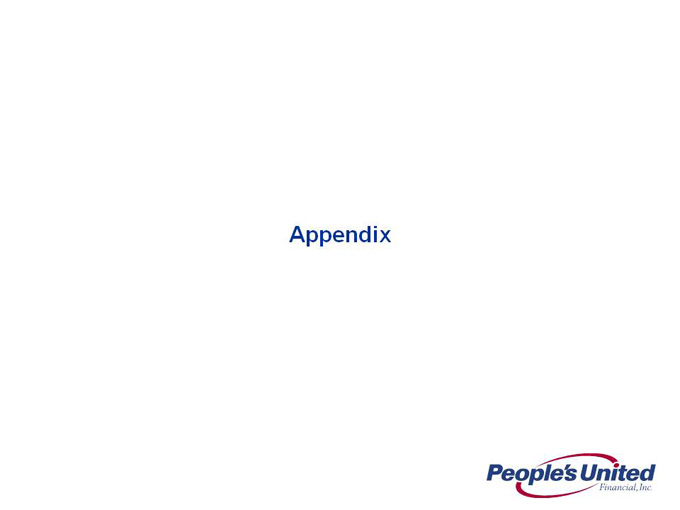
Appendix
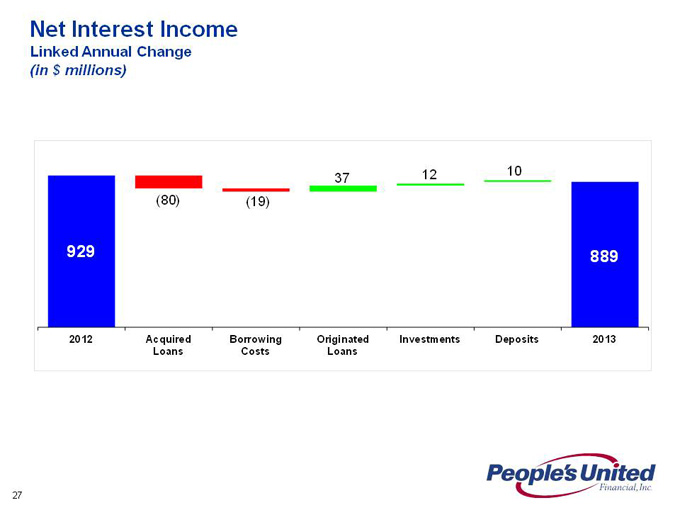
Net Interest Income
Linked Annual Change
(in $ millions)
12 10 37 (80) (19)
929 889
2012 Acquired Borrowing Originated Investments Deposits 2013 Loans Costs Loans
27
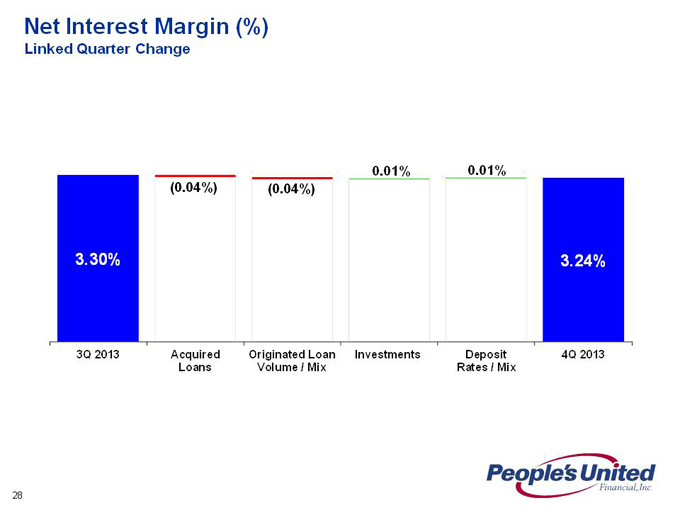
Net Interest Margin (%)
Linked Quarter Change
0.01% 0.01%
(0.04%) (0.04%)
3.30% 3.24%
3Q 2013 Acquired Originated Loan Investments Deposit 4Q 2013 Loans Volume / Mix Rates / Mix
28
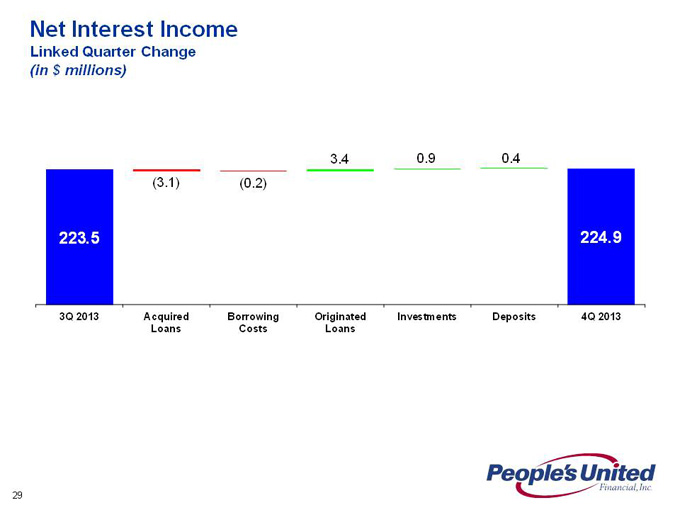
Net Interest Income
Linked Quarter Change
(in $ millions)
3.4 0.9 0.4 (3.1) (0.2)
223.5 224.9
3Q 2013 Acquired Borrowing Originated Investments Deposits 4Q 2013 Loans Costs Loans
29
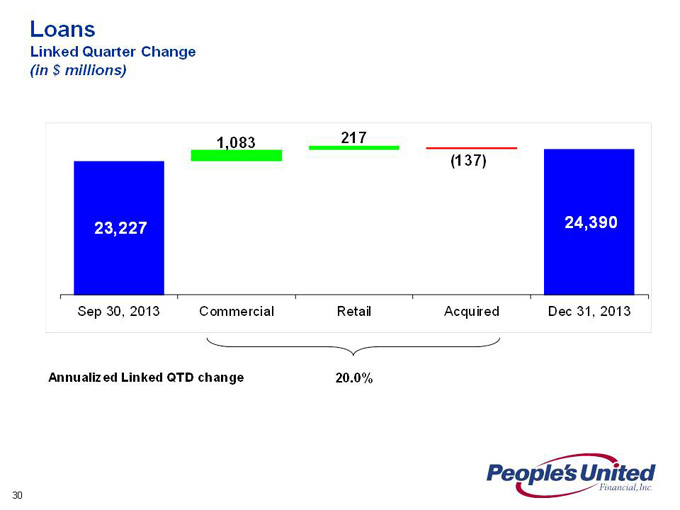
Loans
Linked Quarter Change
(in $ millions)
1,083 217
(137)
23,227 24,390
Sep 30, 2013 Commercial Retail Acquired Dec 31, 2013
Annualized Linked QTD change 20.0%
30
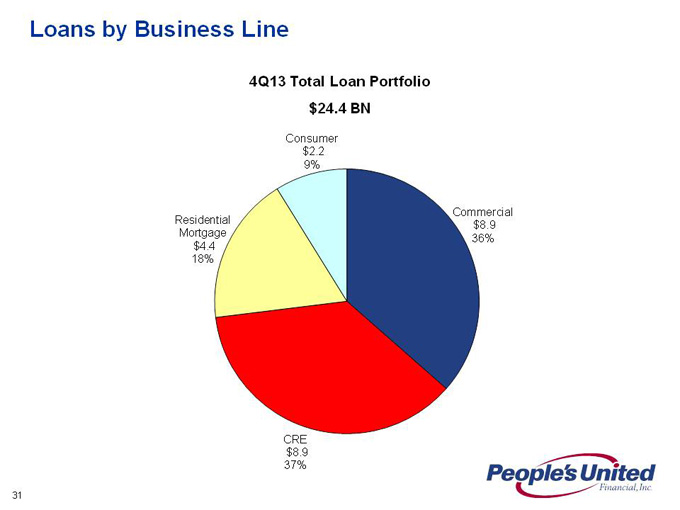
Loans by Business Line
4Q13 Total Loan Portfolio $24.4 BN
Consumer
$2.2 9%
Commercial Residential
$8.9 Mortgage 36%
$4.4 18%
CRE
$8.9 37%
31
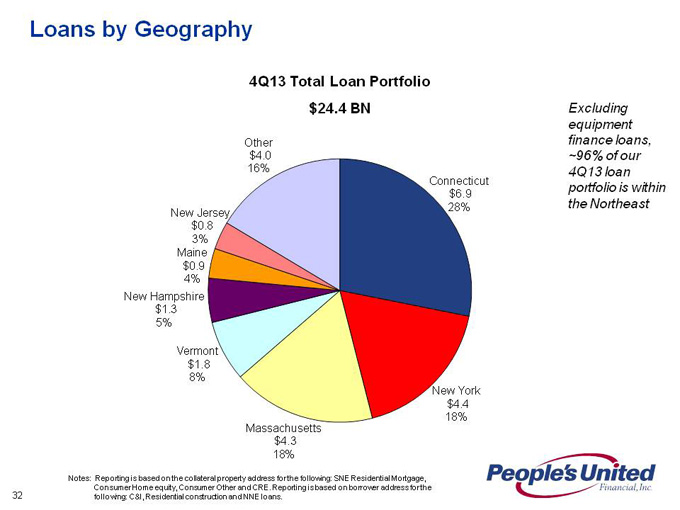
Loans by Geography
4Q13 Total Loan Portfolio
$24.4 BN Excluding equipment Other finance loans,
$4.0 ~96% of our 16% 4Q13 loan
Connecticut portfolio is within
$6.9
28% the Northeast
New Jersey
$0.8 3% Maine
$0.9 4% New Hampshire
$1.3 5%
Vermont
$1.8 8%
New York
$4.4 18% Massachusetts
$4.3 18%
Notes: Reporting is based on the collateral property address for the following: SNE Residential Mortgage, Consumer Home equity, Consumer Other and CRE. Reporting is based on borrower address for the following: C&I, Residential construction and NNE loans.
32
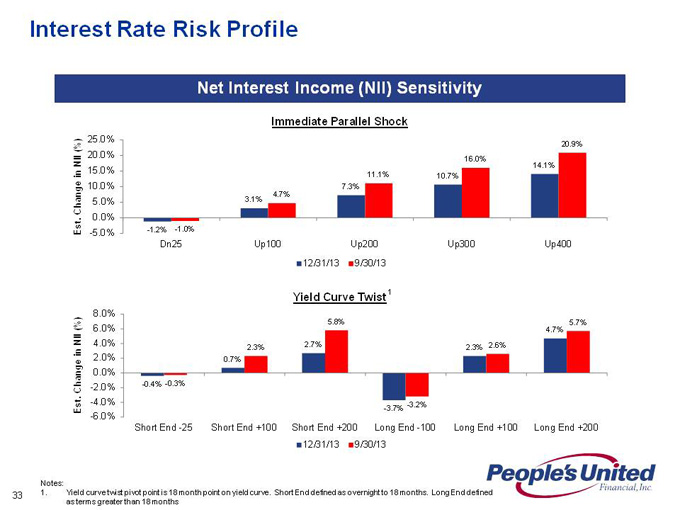
Interest Rate Risk Profile
Net Interest Income (NII) Sensitivity
Immediate Parallel Shock
) 25.0% (% 20.9%
NII 20.0% 16.0% 14.1%
15.0% in 11.1% 10.7% 10.0% 7.3%
4.7% ange 5.0% 3.1% Ch . 0.0%
Est -5.0% -1.2% -1.0%
Dn25 Up100 Up200 Up300 Up400
12/31/13 9/30/13
Yield Curve Twist 1
) 8.0%
% 5.8% 5.7%
( 6.0% 4.7%
NII 4.0% 2.7% 2.6% 2.3% 2.3% in 2.0% 0.7% ange 0.0%
Ch -2.0% -0.4% -0.3% . -4.0% -3.2%
Est -6.0% -3.7%
Short End -25 Short End +100 Short End +200 Long End -100 Long End +100 Long End +200 12/31/13 9/30/13
Notes:
1. Yield curve twist pivot point is 18 month point on yield curve. Short End defined as overnight to 18 months. Long End defined as terms greater than 18 months
33
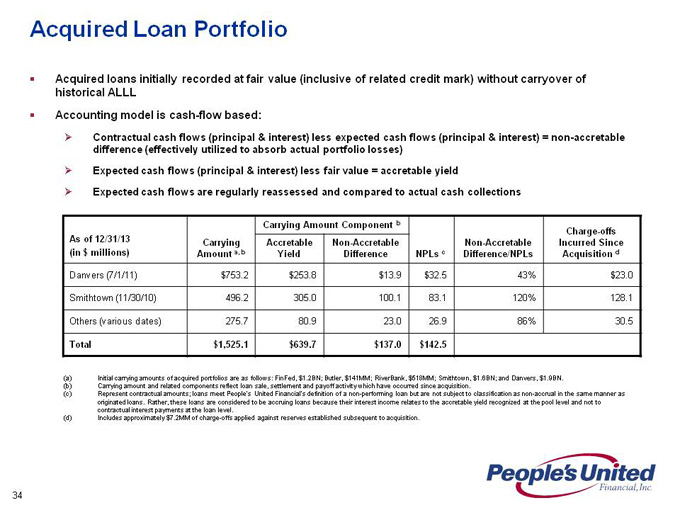
Acquired Loan Portfolio
Acquired loans initially recorded at fair value (inclusive of related credit mark) without carryover of historical ALLL
Accounting model is cash-flow based:
Contractual cash flows (principal & interest) less expected cash flows (principal & interest) = non-accretable difference (effectively utilized to absorb actual portfolio losses)
Expected cash flows (principal & interest) less fair value = accretable yield
Expected cash flows are regularly reassessed and compared to actual cash collections
Carrying Amount Component b
Charge-offs
As of 12/31/13 Carrying Accretable Non-Accretable Non-Accretable Incurred Since
(in $ millions) Amount a, b Yield Difference NPLs c Difference/NPLs Acquisition d
Danvers (7/1/11) $753.2 $253.8 $13.9 $32.5 43% $23.0
Smithtown (11/30/10) 496.2 305.0 100.1 83.1 120% 128.1
Others (various dates) 275.7 80.9 23.0 26.9 86% 30.5
Total $1,525.1 $639.7 $137.0 $142.5
(a) Initial carrying amounts of acquired portfolios are as follows: FinFed, $1.2BN; Butler, $141MM; RiverBank, $518MM; Smithtown, $1.6BN; and Danvers, $1.9BN. (b) Carrying amount and related components reflect loan sale, settlement and payoff activity which have occurred since acquisition.
(c) Represent contractual amounts; loans meet People’s United Financial’s definition of a non-performing loan but are not subject to classification as non-accrual in the same manner as originated loans. Rather, these loans are considered to be accruing loans because their interest income relates to the accretable yield recognized at the pool level and not to contractual interest payments at the loan level.
(d) Includes approximately $7.2MM of charge-offs applied against reserves established subsequent to acquisition.
34
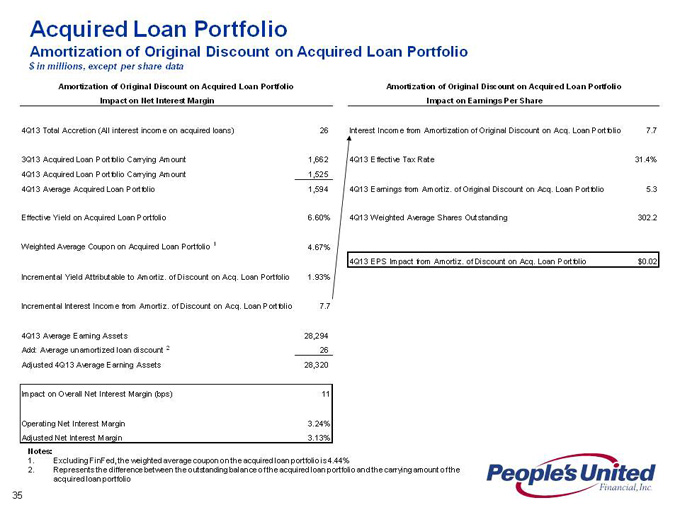
Acquired Loan Portfolio
Amortization of Original Discount on Acquired Loan Portfolio
$ in millions, except per share data
Amortization of Original Discount on Acquired Loan Portfolio Amortization of Original Discount on Acquired Loan Portfolio
Impact on Net Interest Margin Impact on Earnings Per Share
4Q13 Total Accretion (All interest income on acquired loans) 26 Interest Income from Amortization of Original Discount on Acq. Loan Portfolio 7.7
3Q13 Acquired Loan Portfolio Carrying Amount 1,662 4Q13 Effective Tax Rate 31.4%
4Q13 Acquired Loan Portfolio Carrying Amount 1,525
4Q13 Average Acquired Loan Portfolio 1,594 4Q13 Earnings from Amortiz. of Original Discount on Acq. Loan Portfolio 5.3
Effective Yield on Acquired Loan Portfolio 6.60% 4Q13 Weighted Average Shares Outstanding 302.2
Weighted Average Coupon on Acquired Loan Portfolio 1 4.67%
4Q13 EPS Impact from Amortiz. of Discount on Acq. Loan Portfolio $0.02
Incremental Yield Attributable to Amortiz. of Discount on Acq. Loan Portfolio 1.93%
Incremental Interest Income from Amortiz. of Discount on Acq. Loan Portfolio 7.7
4Q13 Average Earning Assets 28,294
Add: Average unamortized loan discount 2 26
Adjusted 4Q13 Average Earning Assets 28,320
Impact on Overall Net Interest Margin (bps) 11
Operating Net Interest Margin 3.24%
Adjusted Net Interest Margin 3.13%
Notes:
1. Excluding FinFed, the weighted average coupon on the acquired loan portfolio is 4.44%
2. Represents the difference between the outstanding balance of the acquired loan portfolio and the carrying amount of the
acquired loan portfolio
35
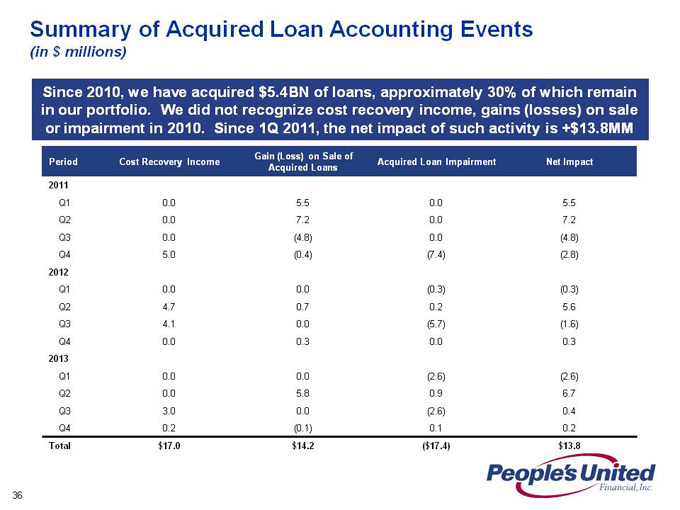
Summary of Acquired Loan Accounting Events
(in $ millions)
Since 2010, we have acquired $5.4BN of loans, approximately 30% of which remain in our portfolio. We did not recognize cost recovery income, gains (losses) on sale or impairment in 2010. Since 1Q 2011, the net impact of such activity is +$13.8MM
Gain (Loss) on Sale of
Period Cost Recovery Income Acquired Loan Impairment Net Impact
Acquired Loans
2011
Q1 0.0 5.5 0.0 5.5
Q2 0.0 7.2 0.0 7.2
Q3 0.0(4.8) 0.0(4.8)
Q4 5.0(0.4)(7.4)(2.8)
2012
Q1 0.0 0.0(0.3)(0.3)
Q2 4.7 0.7 0.2 5.6
Q3 4.1 0.0(5.7)(1.6)
Q4 0.0 0.3 0.0 0.3
2013
Q1 0.0 0.0(2.6)(2.6)
Q2 0.0 5.8 0.9 6.7
Q3 3.0 0.0(2.6) 0.4
Q4 0.2(0.1) 0.1 0.2
Total $17.0 $14.2($17.4) $13.8
36
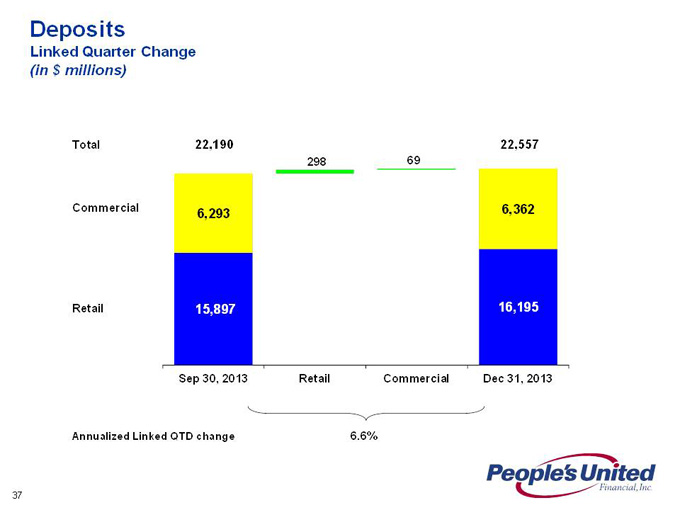
Deposits
Linked Quarter Change
(in $ millions)
Total 22,190 22,557
298 69
Commercial 6,293 6,362 Retail 15,897 16,195 Sep 30, 2013 Retail Commercial Dec 31, 2013
Annualized Linked QTD change 6.6%
37
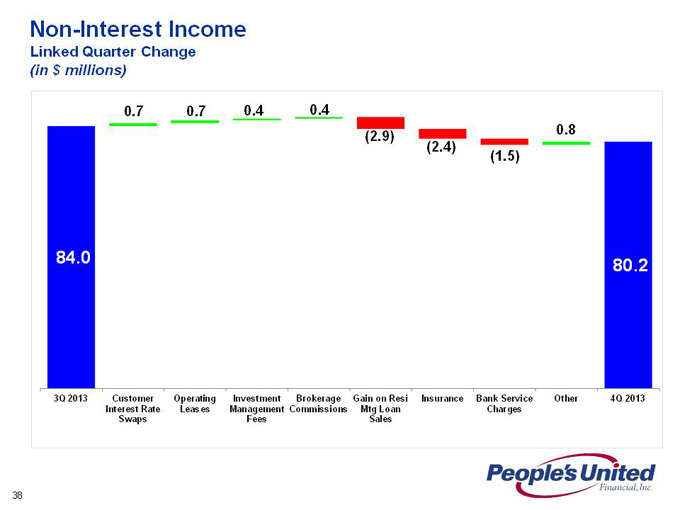
Non-Interest Income
Linked Quarter Change
(in $ millions)
0.7 0.7 0.4 0.4
0.8 (2.9) (2.4) (1.5)
84.0 80.2
3Q 2013 Customer Operating Investment Brokerage Gain on Resi Insurance Bank Service Other 4Q 2013 Interest Rate Leases Management Commissions Mtg Loan Charges Swaps Fees Sales
38
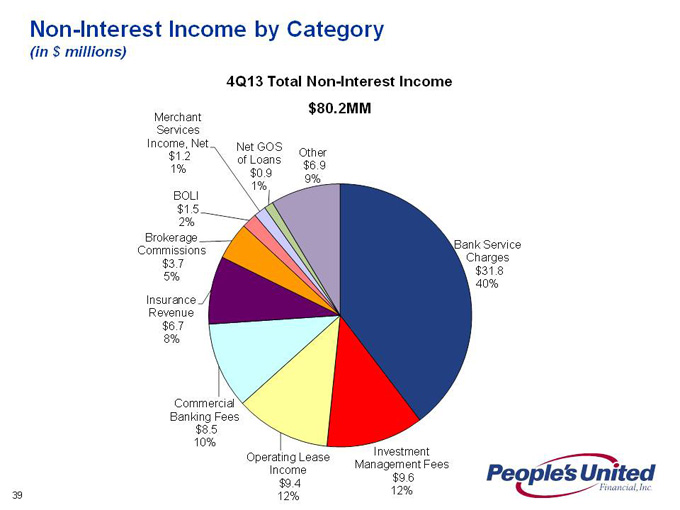
Non-Interest Income by Category
(in $ millions)
4Q13 Total Non-Interest Income $80.2MM
Merchant Services
Income, Net Net GOS
$1.2 Other of Loans
1% $6.9
$0.9
9% BOLI 1%
$1.5 2% Brokerage
Bank Service Commissions Charges
$3.7 $31.8 5% 40% Insurance Revenue
$6.7 8%
Commercial Banking Fees
$8.5 10%
Investment Operating Lease Management Fees Income
$9.6
$9.4
12% 12%
39
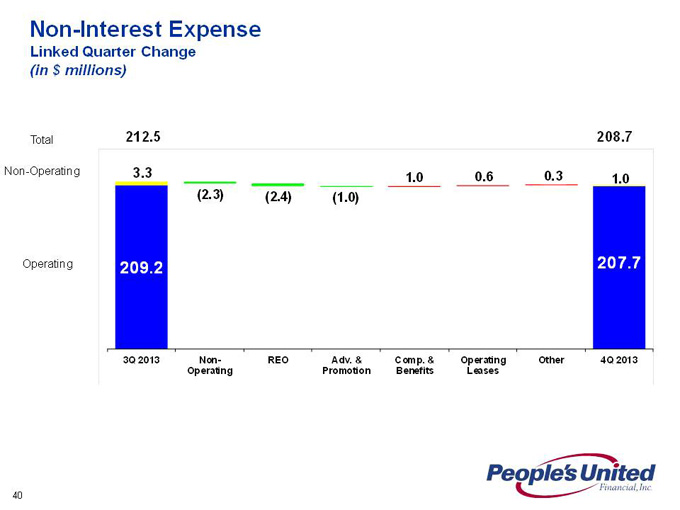
Non-Interest Expense
Linked Quarter Change
(in $ millions)
Total 212.5 208.7
Non-Operating 3.3 0.6 0.3
1.0 1.0
(2.3) (2.4) (1.0)
Operating 209.2 207.7
3Q 2013 Non- REO Adv. & Comp. & Operating Other 4Q 2013 Operating Promotion Benefits Leases
40
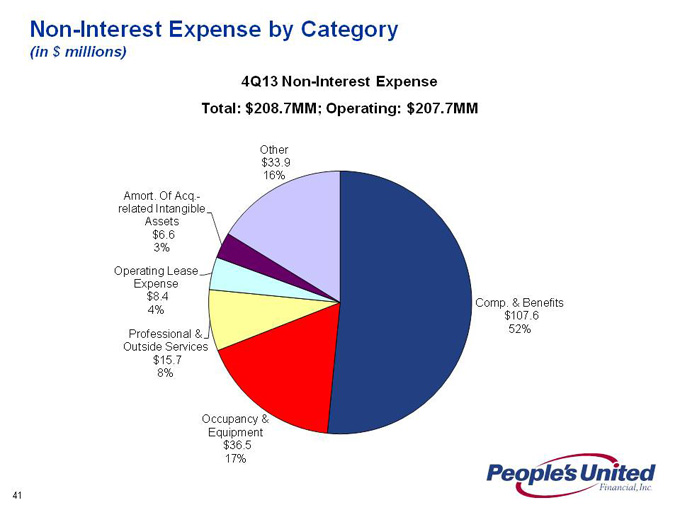
Non-Interest Expense by Category
(in $ millions)
4Q13 Non-Interest Expense Total: $208.7MM; Operating: $207.7MM
Other
$33.9 16% Amort. Of Acq.-related Intangible Assets
$6.6 3%
Operating Lease Expense
$8.4
Comp. & Benefits 4% $107.6 52% Professional & Outside Services
$15.7 8%
Occupancy & Equipment
$36.5 17%
41
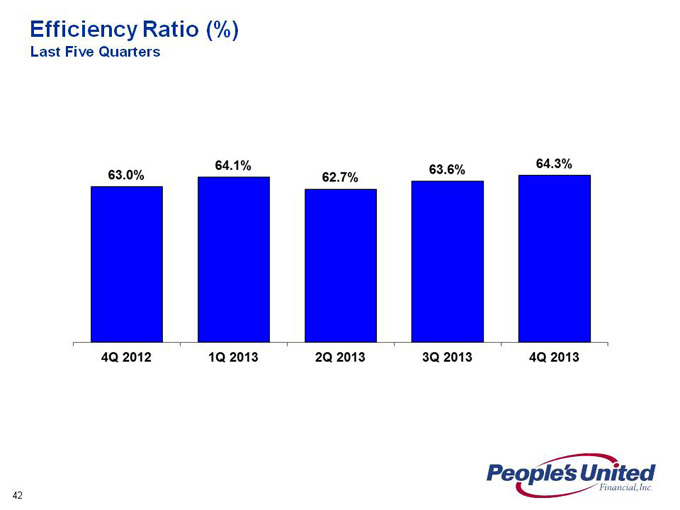
Efficiency Ratio (%)
Last Five Quarters
42
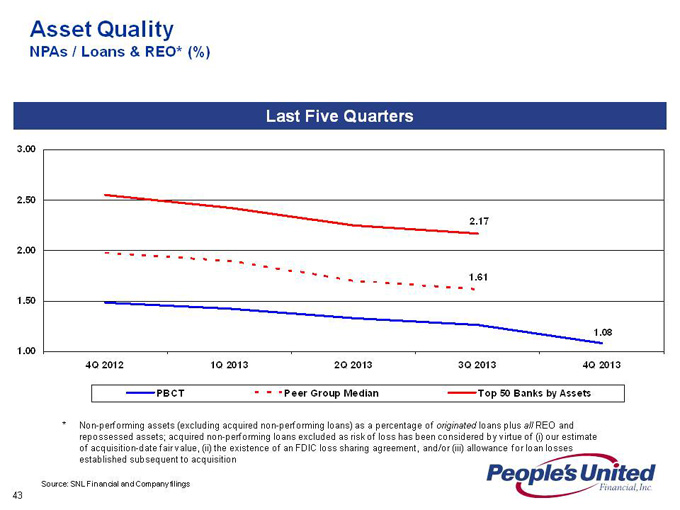
Asset Quality
NPAs / Loans & REO* (%)
Last Five Quarters
3.00
2.50
2.17
2.00
1.61
1.50
1.08
1.00
4Q 2012 1Q 2013 2Q 2013 3Q 2013 4Q 2013 PBCT Peer Group Median Top 50 Banks by Assets
* Non-performing assets (excluding acquired non-performing loans) as a percentage of originated loans plus all REO and repossessed assets; acquired non-performing loans excluded as risk of loss has been considered by virtue of (i) our estimate of acquisition-date fair value, (ii) the existence of an FDIC loss sharing agreement, and/or (iii) allowance for loan losses established subsequent to acquisition
Source: SNL Financial and Company filings
43
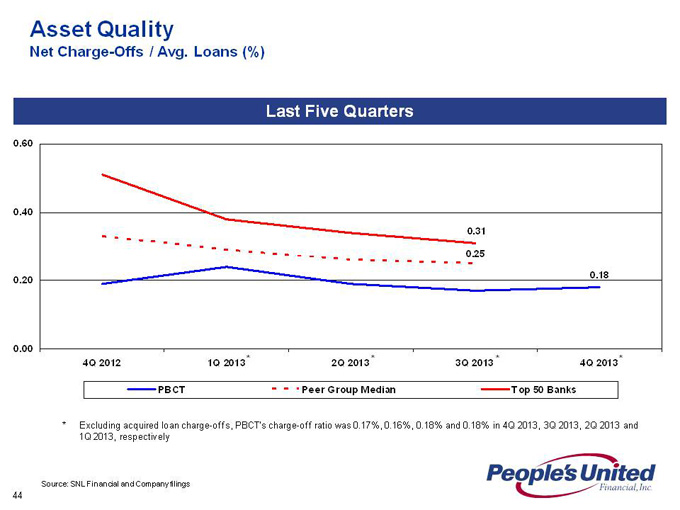
Asset Quality
Net Charge-Offs / Avg. Loans (%)
Last Five Quarters
0.60
0.40
0.31
0.25
0.18
0.20
0.00
4Q 2012 1Q 2013* 2Q 2013 * 3Q 2013 * 4Q 2013* PBCT Peer Group Median Top 50 Banks
* Excluding acquired loan charge-offs, PBCT’s charge-off ratio was 0.17%, 0.16%, 0.18% and 0.18% in 4Q 2013, 3Q 2013, 2Q 2013 and
1Q 2013, respectively
Source: SNL Financial and Company filings
44
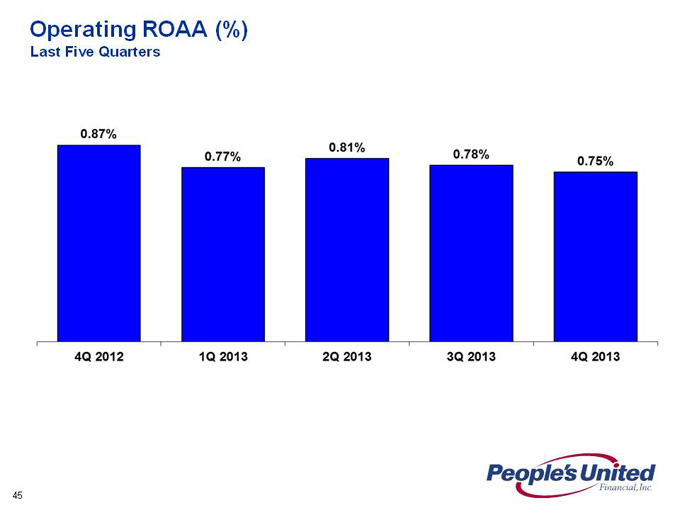
Operating ROAA (%)
Last Five Quarters
45
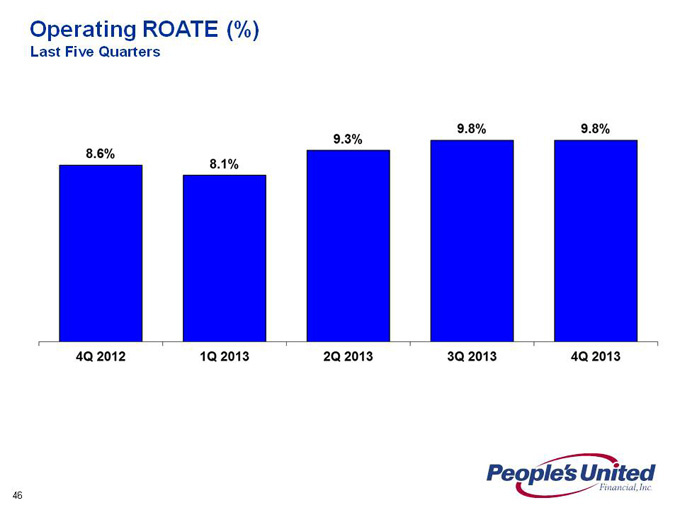
Operating ROATE (%)
Last Five Quarters
46
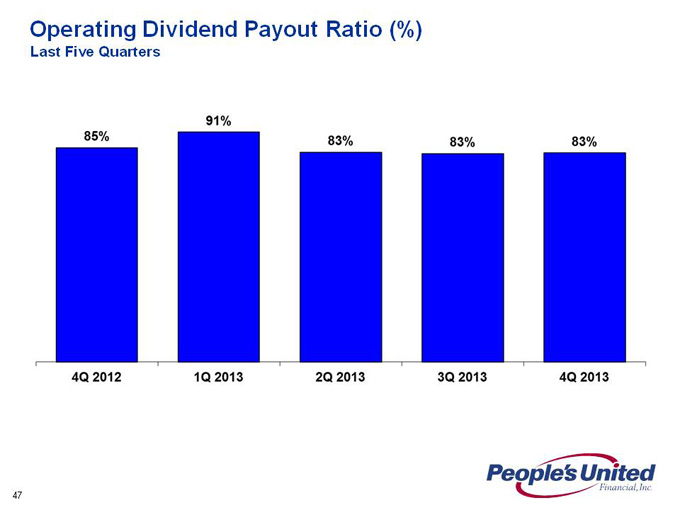
Operating Dividend Payout Ratio (%)
Last Five Quarters
47
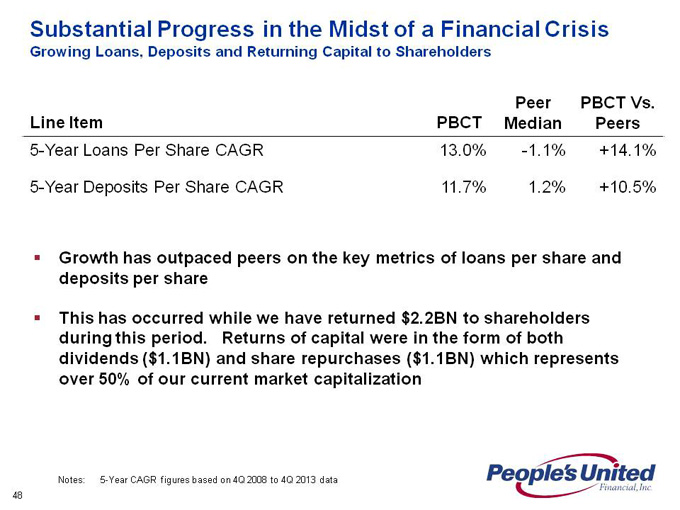
Substantial Progress in the Midst of a Financial Crisis
Growing Loans, Deposits and Returning Capital to Shareholders
Peer PBCT Vs. Line Item PBCT Median Peers
5-Year Loans Per Share CAGR 13.0% -1.1% +14.1%
5-Year Deposits Per Share CAGR 11.7% 1.2% +10.5%
Growth has outpaced peers on the key metrics of loans per share and deposits per share
This has occurred while we have returned $2.2BN to shareholders during this period. Returns of capital were in the form of both dividends ($1.1BN) and share repurchases ($1.1BN) which represents over 50% of our current market capitalization
Notes: 5-Year CAGR figures based on 4Q 2008 to 4Q 2013 data
48
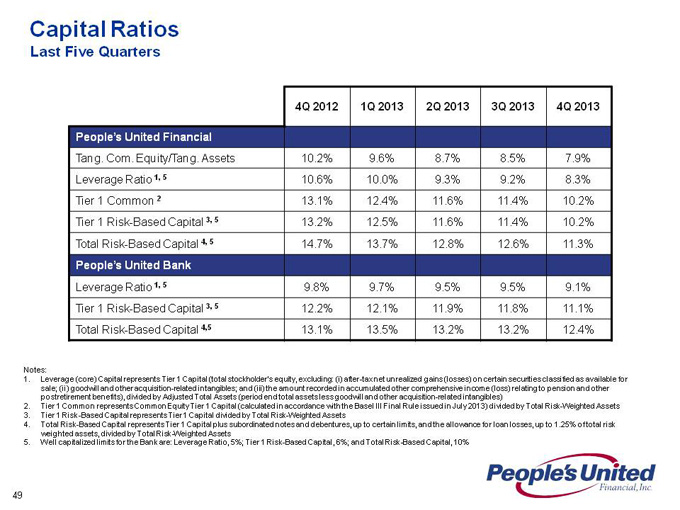
Capital Ratios
Last Five Quarters
4Q 2012 1Q 2013 2Q 2013 3Q 2013 4Q 2013
People’s United Financial
Tang. Com. Equity/Tang. Assets 10.2% 9.6% 8.7% 8.5% 7.9%
Leverage Ratio 1, 5 10.6% 10.0% 9.3% 9.2% 8.3%
Tier 1 Common 2 13.1% 12.4% 11.6% 11.4% 10.2%
Tier 1 Risk-Based Capital 3, 5 13.2% 12.5% 11.6% 11.4% 10.2%
Total Risk-Based Capital 4, 5 14.7% 13.7% 12.8% 12.6% 11.3%
People’s United Bank
Leverage Ratio 1, 5 9.8% 9.7% 9.5% 9.5% 9.1%
Tier 1 Risk-Based Capital 3, 5 12.2% 12.1% 11.9% 11.8% 11.1%
Total Risk-Based Capital 4,5 13.1% 13.5% 13.2% 13.2% 12.4%
Notes:
1. Leverage (core) Capital represents Tier 1 Capital (total stockholder’s equity, excluding: (i) after-tax net unrealized gains (losses) on certain securities classified as available for sale; (ii) goodwill and other acquisition-related intangibles; and (iii) the amount recorded in accumulated other comprehensive income (loss) relating to pension and other postretirement benefits), divided by Adjusted Total Assets (period end total assets less goodwill and other acquisition-related intangibles)
2. Tier 1 Common represents Common Equity Tier 1 Capital (calculated in accordance with the Basel III Final Rule issued in July 2013) divided by Total Risk-Weighted Assets
3. Tier 1 Risk-Based Capital represents Tier 1 Capital divided by Total Risk-Weighted Assets
4. Total Risk-Based Capital represents Tier 1 Capital plus subordinated notes and debentures, up to certain limits, and the allowance for loan losses, up to 1.25% of total risk weighted assets, divided by Total Risk-Weighted Assets
5. Well capitalized limits for the Bank are: Leverage Ratio, 5%; Tier 1 Risk-Based Capital, 6%; and Total Risk-Based Capital, 10%
49
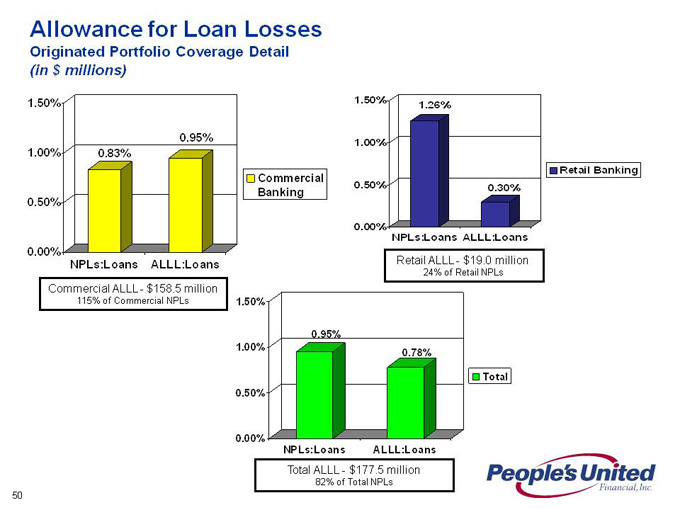
Allowance for Loan Losses
Originated Portfolio Coverage Detail
(in $ millions)
1.50% 1.50% 1.26% 0.95% 1.00% 1.00% 0.83%
Retail Banking
Commercial
0.50% 0.30%
Banking
0.50% 0.00%
NPLs:Loans ALLL:Loans
0.00%
Retail ALLL—$19.0 million
NPLs:Loans ALLL:Loans
24% of Retail NPLs
Commercial ALLL—$158.5 million
115% of Commercial NPLs 1.50%
0.95% 1.00% 0.78%
Total
0.00%
NPLs:Loans ALLL:Loans
Total ALLL—$177.5 million
82% of Total NPLs
50
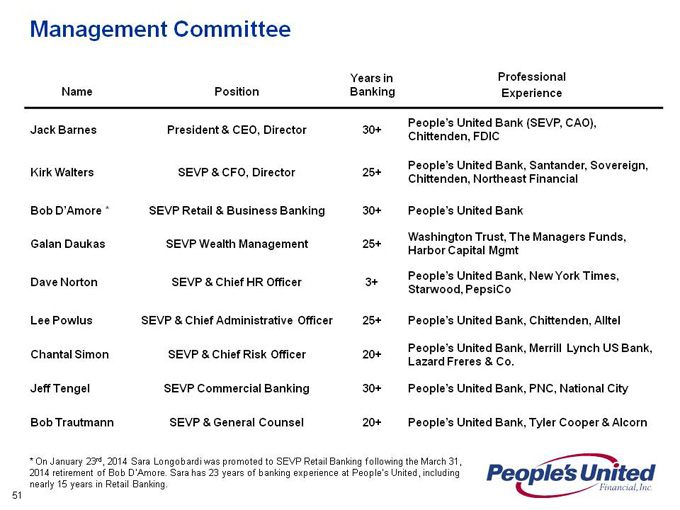
Management Committee
Years in Professional Name Position Banking Experience
People’s United Bank (SEVP, CAO),
Jack Barnes President & CEO, Director 30+
Chittenden, FDIC
People’s United Bank, Santander, Sovereign,
Kirk Walters SEVP & CFO, Director 25+
Chittenden, Northeast Financial
Bob D’Amore * SEVP Retail & Business Banking 30+ People’s United Bank
Washington Trust, The Managers Funds, Galan Daukas SEVP Wealth Management 25+ Harbor Capital Mgmt
People’s United Bank, New York Times,
Dave Norton SEVP & Chief HR Officer 3+
Starwood, PepsiCo
Lee Powlus SEVP & Chief Administrative Officer 25+ People’s United Bank, Chittenden, Alltel
People’s United Bank, Merrill Lynch US Bank,
Chantal Simon SEVP & Chief Risk Officer 20+
Lazard Freres & Co.
Jeff Tengel SEVP Commercial Banking 30+ People’s United Bank, PNC, National City
Bob Trautmann SEVP & General Counsel 20+ People’s United Bank, Tyler Cooper & Alcorn
* |
| On January 23rd, 2014 Sara Longobardi was promoted to SEVP Retail Banking following the March 31, |
2014 retirement of Bob D’Amore. Sara has 23 years of banking experience at People’s United, including nearly 15 years in Retail Banking.
51

Peer Group
Firm Ticker City State
1 |
| Associated ASBC Green Bay WI |
2 |
| BancorpSouth BXS Tupelo MS |
3 |
| City National CYN Los Angeles CA |
4 |
| Comerica CMA Dallas TX |
5 |
| Commerce CBSH Kansas City MO |
6 |
| Cullen/Frost CFR San Antonio TX |
7 |
| East West EWBC Pasadena CA |
8 |
| First Niagara FNFG Buffalo NY |
9 FirstMerit FMER Akron OH
10 |
| Fulton FULT Lancaster PA |
11 |
| Huntington HBAN Columbus OH |
12 |
| M&T MTB Buffalo NY |
13 |
| New York Community NYCB Westbury NY |
14 |
| Signature SBNY New York NY |
15 |
| Susquehanna SUSQ Lititz PA |
16 |
| Synovus SNV Columbus GA |
17 |
| Valley National VLY Wayne NJ |
18 |
| Webster WBS Waterbury CT |
19 |
| Wintrust WTFC Lake Forest IL |
20 |
| Zions ZION Salt Lake City UT |
52
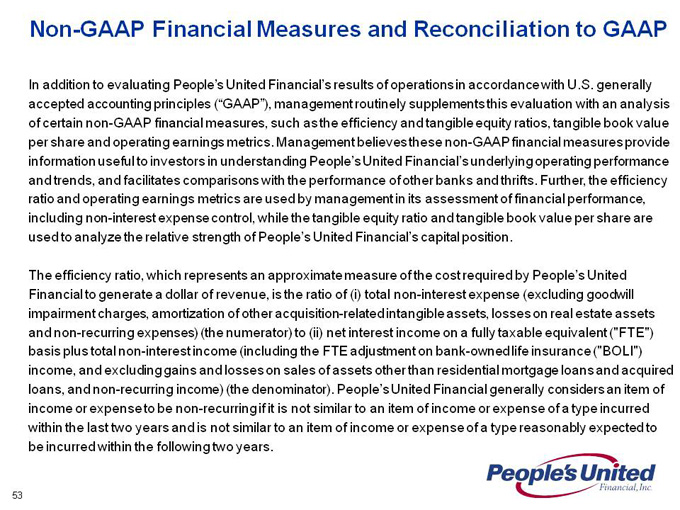
Non-GAAP Financial Measures and Reconciliation to GAAP
In addition to evaluating People’s United Financial’s results of operations in accordance with U.S. generally accepted accounting principles (“GAAP”), management routinely supplements this evaluation with an analysis of certain non-GAAP financial measures, such as the efficiency and tangible equity ratios, tangible book value per share and operating earnings metrics. Management believes these non-GAAP financial measures provide information useful to investors in understanding People’s United Financial’s underlying operating performance and trends, and facilitates comparisons with the performance of other banks and thrifts. Further, the efficiency ratio and operating earnings metrics are used by management in its assessment of financial performance, including non-interest expense control, while the tangible equity ratio and tangible book value per share are used to analyze the relative strength of People’s United Financial’s capital position.
The efficiency ratio, which represents an approximate measure of the cost required by People’s United
Financial to generate a dollar of revenue, is the ratio of (i) total non-interest expense (excluding goodwill impairment charges, amortization of other acquisition-related intangible assets, losses on real estate assets and non-recurring expenses) (the numerator) to (ii) net interest income on a fully taxable equivalent (“FTE”) basis plus total non-interest income (including the FTE adjustment on bank-owned life insurance (“BOLI”) income, and excluding gains and losses on sales of assets other than residential mortgage loans and acquired loans, and non-recurring income) (the denominator). People’s United Financial generally considers an item of income or expense to be non-recurring if it is not similar to an item of income or expense of a type incurred within the last two years and is not similar to an item of income or expense of a type reasonably expected to be incurred within the following two years.
53
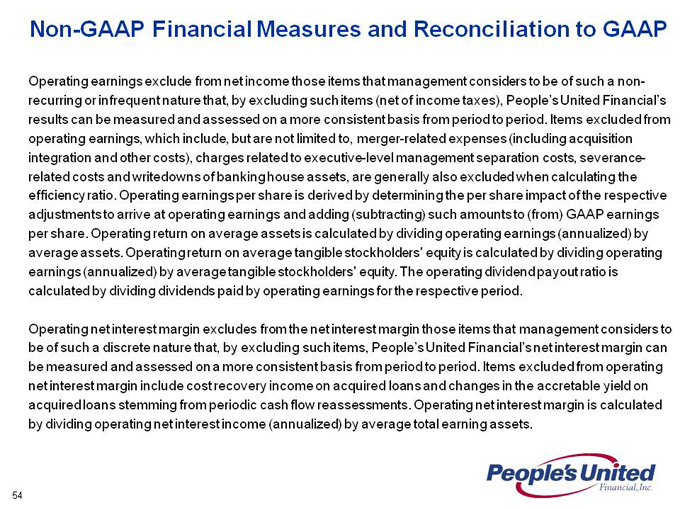
Non-GAAP Financial Measures and Reconciliation to GAAP
Operating earnings exclude from net income those items that management considers to be of such a non-recurring or infrequent nature that, by excluding such items (net of income taxes), People’s United Financial’s results can be measured and assessed on a more consistent basis from period to period. Items excluded from operating earnings, which include, but are not limited to, merger-related expenses (including acquisition integration and other costs), charges related to executive-level management separation costs, severance-related costs and writedowns of banking house assets, are generally also excluded when calculating the efficiency ratio. Operating earnings per share is derived by determining the per share impact of the respective adjustments to arrive at operating earnings and adding (subtracting) such amounts to (from) GAAP earnings per share. Operating return on average assets is calculated by dividing operating earnings (annualized) by average assets. Operating return on average tangible stockholders’ equity is calculated by dividing operating earnings (annualized) by average tangible stockholders’ equity. The operating dividend payout ratio is calculated by dividing dividends paid by operating earnings for the respective period.
Operating net interest margin excludes from the net interest margin those items that management considers to be of such a discrete nature that, by excluding such items, People’s United Financial’s net interest margin can be measured and assessed on a more consistent basis from period to period. Items excluded from operating net interest margin include cost recovery income on acquired loans and changes in the accretable yield on acquired loans stemming from periodic cash flow reassessments. Operating net interest margin is calculated by dividing operating net interest income (annualized) by average total earning assets.
54
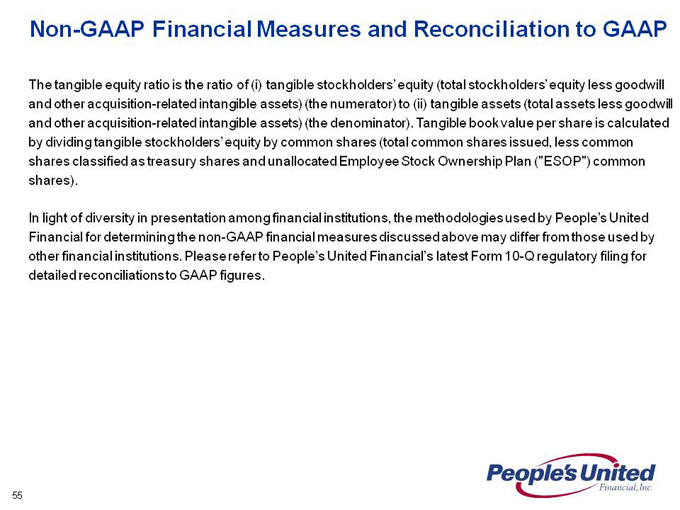
Non-GAAP Financial Measures and Reconciliation to GAAP
The tangible equity ratio is the ratio of (i) tangible stockholders’ equity (total stockholders’ equity less goodwill and other acquisition-related intangible assets) (the numerator) to (ii) tangible assets (total assets less goodwill and other acquisition-related intangible assets) (the denominator). Tangible book value per share is calculated by dividing tangible stockholders’ equity by common shares (total common shares issued, less common shares classified as treasury shares and unallocated Employee Stock Ownership Plan (“ESOP”) common shares).
In light of diversity in presentation among financial institutions, the methodologies used by People’s United
Financial for determining the non-GAAP financial measures discussed above may differ from those used by other financial institutions. Please refer to People’s United Financial’s latest Form 10-Q regulatory filing for detailed reconciliations to GAAP figures.
55

For more information, investors may contact: Peter Goulding, CFA
203-338-6799 peter.goulding@peoples.com